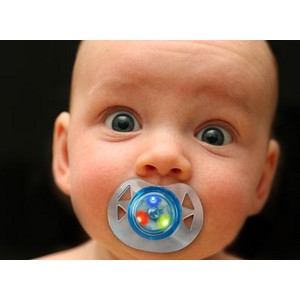When and how to get rid of your Baby’s Pacifier
Many babies are calmed and soothed by sucking on pacifiers during naps or at bedtime. Pacifiers can be a very positive experience for your children, especially during their first six months of development. In addition to its calming effect, studies indicate that pacifier use in infants can help decrease the risk of sudden infant death syndrome (SIDS) and aid in the development of jaw muscles. While generally a healthy habit within the first two years of life, continued or improper use of pacifiers may ultimately negatively impact your child’s health.
Potential pacifier problems
 Pacifier use is typically acceptable after an infant is one month old and has had sufficient time to develop a healthy breastfeeding habit. However, experts recommend that children stop using pacifiers after their second year, when it becomes more of a habit than a developmental need. Research shows that continued pacifier use, especially after age 2, is often associated with the following:
Pacifier use is typically acceptable after an infant is one month old and has had sufficient time to develop a healthy breastfeeding habit. However, experts recommend that children stop using pacifiers after their second year, when it becomes more of a habit than a developmental need. Research shows that continued pacifier use, especially after age 2, is often associated with the following:
- Increased risk of middle ear infection
- Improper growth of the mouth
- Misalignment of teeth
- Dental Crossbite and/or openbite
- Development of thumb sucking habit
Tips for correct pacifier use
For infants, correct use and care of pacifiers must be considered. Here are a few tips:
- Purchase orthodontically designed pacifiers
- Clean the pacifier regularly
- Check frequently for cracks, discolorations, and tears in the pacifier’s rubber
- Replace old or damaged pacifiers
- Wash pacifiers prior to first use
- Do not tie pacifiers to your infant’s neck
- Offer pacifiers after and between meals, at naptime or bedtime
Proper pacifier cleaning
The shape and materials used to create pacifiers makes them very susceptible to colonization by bacterial organisms, including Staphylococcus (staph infection). To prevent the spread of bacteria and disease, clean your child’s pacifiers at least once a day. They can be cleaned using mild soap and water. Pacifiers that are dishwasher safe can be cleaned easily using this effective method. When cleaning pacifiers, make sure to remove all excess water from the nipple, where it can collect and cause bacterial growth.
Saying good-bye to the pacifier
For some infants, giving up the pacifier can be difficult, especially when they become emotionally attached to the habit. However, parents looking to wean their children from the pacifier can begin by offering other alternatives, including:
- Rocking motions, singing, or music during naptime/bedtime
- Activities and games
- Toys
Additionally, to further help break the pacifier habit, parents can:
- Limit its use gradually over time.
- Reduce pacifier satisfaction by piercing the pacifier’s nipple or trimming the pacifier short.
- Dip the pacifier in a safe, but undesirable flavor, such as white vinegar.
- Go “cold turkey” and refuse to offer the pacifier.
Good luck to all the parents out there. Hope this helps.
Source: Academy of General Dentistry

